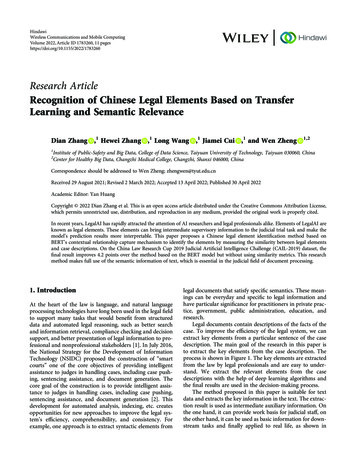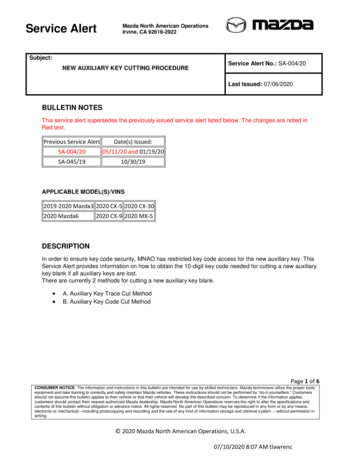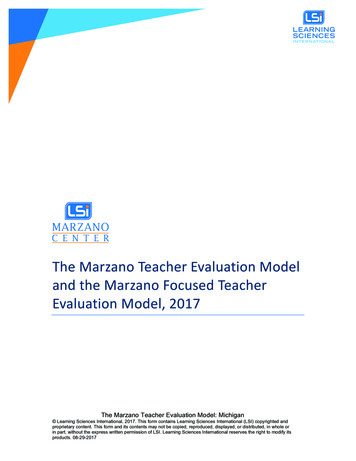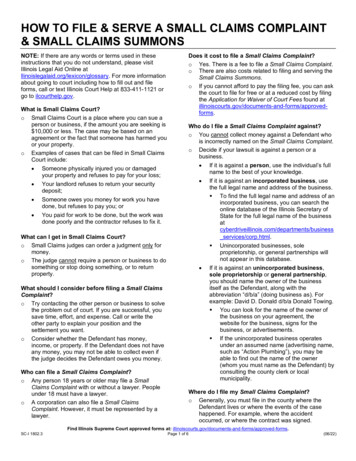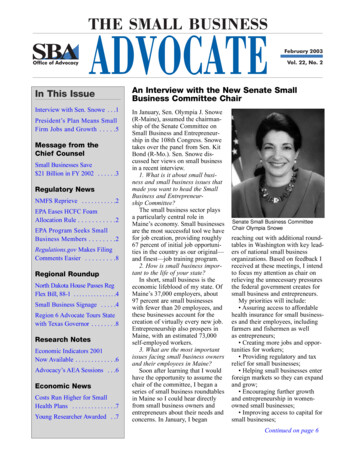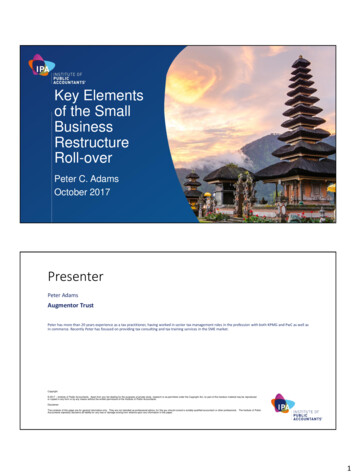
Transcription
Key Elementsof the SmallBusinessRestructureRoll-overPeter C. AdamsOctober 2017PresenterPeter AdamsAugmentor TrustPeter has more than 20 years experience as a tax practitioner, having worked in senior tax management roles in the profession with both KPMG and PwC as well asin commerce. Recently Peter has focused on providing tax consulting and tax training services in the SME market.Copyright 2017 – Institute of Public Accountants. Apart from any fair dealing for the purposes of private study, research or as permitted under the Copyright Act, no part of this handout material may be reproducedor copied in any form or by any means without the written permission of the Institute of Public Accountants.DisclaimerThe contents of this paper are for general information only. They are not intended as professional advice, for this you should consult a suitably qualified accountant or other professional. The Institute of PublicAccountants expressly disclaims all liability for any loss or damage arising from reliance upon any information in this paper.1
Small business entitiesSmall business restructure rollover relief With effect 1 July 2016, the Tax Laws Amendment (Small Business RestructureRoll-Over) Act 2016 provides Australian resident Small Business Entities("SBEs") with a new roll-over for gains and losses arising from the transfer ofCGT assets, trading stock, revenue assets and depreciating assets The roll-over applies if the arrangement is part of a genuine restructure of asmall business where the ultimate economic ownership ("UEO") of the asset(directly or indirectly) does not change.Small business entitiesSmall business restructure rollover relief The legislation enables SBEs to disregard any tax gain or loss made on thetransfer of their business or assets into the new structures. The exclusion does not cover GST or Stamp Duty. Where an individual operates as a sole trader, they hold the UEO. Where the entity is a company, the provisions will look at the ultimateshareholders to determine the UEO. If there is more than one individual who is an ultimate economic owner of anasset, there is an additional requirement that each of those individuals’ sharesof that ultimate economic ownership be materially unchanged, maintaining thesame proportionate ownership in the asset.2
Small business entitiesSmall business restructure rollover relief The provisions specifically provide for the inclusion of discretionary trusts as aneligible entity type by utilising the existing Family Trust Election ("FTE") rules as atest of the UEO. For example, where an individual transfers his/her business to a newlyestablished discretionary trust, the UEO will be deemed not to have changedwhere the trust has made a FTE and the individual is part of the same familygroup. Exempt entities and complying superannuation funds are excluded. This means that assets such as land and buildings cannot be transferred intoSMSF even though there may be no change in UEO. The roll over relief provides for tax neutral consequences for a transfer by"switching off" the application of the existing income tax law - but only for thepurpose of the transfer and not for the purposes of GST, FBT or stamp duty.Tax Update - LegislationTLA (Small Business Restructure Roll-over) Bill 2016 In addition to rollover, certain specific consequences for CGT assets: pre-CGT assets will retain their pre-CGT status in the hands of the transferee for purpose of determining whether capital gain may be discounted, transferee istreated as having acquired the CGT asset at the time of the transfer for purpose of determining eligibility for 15 year CGT exemption for small businesses,transferee will be taken as having acquired asset when transferor acquired it.3
Tax Update - LegislationTLA (Small Business Restructure Roll-over) Bill 2016Eligibility requirements: A small business entity for the income year during which the transfer occurs forCGT assets that are active assets. An affiliate of a small business entity for passively held assets that used by thesmall business entity in its business. A connected entity of a small business entity for passively held assets that areused by the small business entity in its business. A partner in a partnership that is a small business entity for the income yearduring which the transfer occurs for passively held assets that are used by thesmall business entity in its business. Both transferor and transferee must be residents of Australia For partnerships, at least one partner must be an Australian resident. NOTE – no requirement to meet 6m NAV test also (only 2m T/O test)Tax Update - LegislationTLA (Small Business Restructure Roll-over) Bill 2016Ultimate economic ownership requirement: The small business restructuring transaction must not have effect of changingultimate economic ownership of transferred assets in a material way. Ultimate economic owners of an asset are the individuals who, directly orindirectly, beneficially own an asset. Ultimate economic ownership of asset can only be held by natural persons. Where a company, partnership or trust owns an asset it will be the naturalperson owners of the interests in these interposed entities that will ultimatelybenefit economically from that asset.4
Tax Update - LegislationTLA (Small Business Restructure Roll-over) Bill 2016Genuine restructure Transaction must be, or part of, a genuine restructure of an ongoing business EM sets out some factors that would indicate a genuine restructure: it is a bona fide commercial arrangement undertaken to enhance business efficiency business continues to operate following the transfer, through a different entitystructure but under the same ultimate economic ownership transferred assets continue to be used in the business restructure results in a structure likely to have been adopted had the business ownersobtained appropriate professional advice when setting up the business restructure is not artificial or unduly tax driven; and it is not divestment or preliminary step to facilitate economic realisation of assetsTax Update - LegislationTLA (Small Business Restructure Roll-over) Bill 2016Genuine restructure - safe harbour: Bill provides a safe harbour which deems a SBE to satisfy genuine restructurerequirement where, for three years following roll-over: there is no change in ultimate economic ownership of assets of the business (otherthan trading stock) that were transferred under the transaction those significant assets continue to be active assets; and there is no significant or material use of those significant assets for private purposes.5
Small business entitiesExample – Small business restructure rollover relief (SBRR) Pep and Sally, a married couple, are directors and shareholders in Vitamin Pty Ltdwhich has issued two shares. Vitamin Pty Ltd carries on a naturopathy business. A new discretionary trust, the P&S Trust, is settled and a family trust election ismade with Pep as the primary individual. On 1 January 2017, Pep and Sally cause Vitamin Pty Ltd to transfer all of its assets(except petty cash) to the trustee of the P&S Trust (the trustee) in considerationfor the trustee undertaking to discharge Vitamin Pty Ltd's liabilities. The company and the trustee choose to apply the SBRR.Small business entitiesExample – Small business restructure rollover relief (SBRR) As at 1 January 2017, the active assets of the company are: a small consulting room, which was acquired by Vitamin Pty Ltd for 200,000in 2010. The market value is 230,000. a pill pressing machine, with an adjustable value of 14,000 goodwill, which is self-generated, and 50 bottles of homeopathic pills, which became Vitamin Pty Ltd's trading stockduring the income year at a cost of 250.6
Small business entitiesExample – Small business restructure rollover relief (SBRR) No capital gain or loss arises from the transfer of the consulting room or goodwill. The trustee is taken to have acquired the consulting room at the time of thetransfer for 200,000, being Vitamin Pty Ltd's cost base for the asset immediatelybefore the transfer takes effect.Small business entitiesExample – Small business restructure rollover relief (SBRR) No amount is included in Vitamin Pty Ltd's assessable income, or deductionallowed, as a result of a balancing adjustment event for the transfer of the pillpressing machine. The trustee's cost for the pill press is its adjustable value to Vitamin Pty Ltd justbefore the transfer ( 14,000). The trustee can deduct the decline in value of the pill press using the samemethod and effective life (or remaining effective life, if using the prime costmethod) as Vitamin Pty Ltd was using. The trustee is taken to have acquired the goodwill at the time of the transfer for 0, being Vitamin's Pty Ltd's cost base for the goodwill immediately before thetransfer takes effect.7
Small business entitiesExample – Small business restructure rollover relief (SBRR) As a result of the disposal of the pills to the trustee, Vitamin Pty Ltd is taken tohave transferred the pills for their cost ( 250) and not for their market value.Vitamin Pty Ltd includes 250 in its assessable income under section 70-90. The pills are trading stock on hand in the hands of the trustee. No dividend arises as a result of the transfer of CGT assets (that are notdepreciating assets) by Vitamin Pty Ltd (including any 'deemed dividend' underDivision 7A of Part III of the ITAA 1936 or any other provision of the tax law). Apart from pre-CGT assets, the transferee acquires the asset at the time of thetransfer. That is, the time of acquisition is not altered by Subdivision 328-G. Following the transfer of assets to the trustee of the P&S trust, a propertyinvestor makes an attractive offer to the trustee for the consulting room. On 30 September 2017, the trustee enters into an agreement for the sale of theconsulting room. Trustee disposes of the room and CGT event A1 happens on 30 September 2017.Small business entitiesExample – Small business restructure rollover relief (SBRR) Trustee is treated as having acquired the CGT asset at the time of the SBRRtransfer, on 1 January 2017. The trustee is not entitled to access the 50% general CGT discount on disposal,as the trustee acquired the asset less than a year before the CGT event causingthis gain. However, for the purpose of determining eligibility for the 15 year CGTexemption for small businesses, the transferee will be taken as havingacquired the asset when the transferor acquired it.8
CLOSEQUESTIONS? .9
TLA (Small Business Restructure Roll-over) Bill 2016 Eligibility requirements: A small business entity for the income year during which the transfer occurs for CGT assets that are active assets. An affiliate of a small business entity for passively held assets that used by the small business entity in its business.



